Mushroom
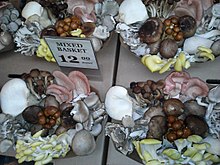
A mushroom or toadstool is the fleshy,
The standard for the name "mushroom" is the cultivated white button mushroom, Agaricus bisporus; hence, the word "mushroom" is most often applied to those fungi (Basidiomycota, Agaricomycetes) that have a stem (stipe), a cap (pileus), and gills (lamellae, sing. lamella) on the underside of the cap. "Mushroom" also describes a variety of other gilled fungi, with or without stems; therefore the term is used to describe the fleshy fruiting bodies of some Ascomycota. The gills produce microscopic spores which help the fungus spread across the ground or its occupant surface.
Forms deviating from the standard
Etymology
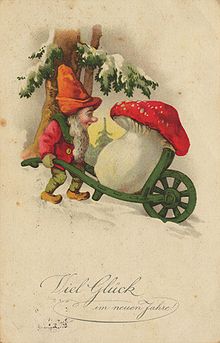
The terms "mushroom" and "toadstool" go back centuries and were never precisely defined, nor was there consensus on application. During the 15th and 16th centuries, the terms mushrom, mushrum, muscheron, mousheroms, mussheron, or musserouns were used.[3]
The term "mushroom" and its variations may have been derived from the French word mousseron in reference to moss (mousse). Delineation between edible and poisonous fungi is not clear-cut, so a "mushroom" may be edible, poisonous, or unpalatable.[4][5] The word toadstool appeared first in 14th century England as a reference for a "stool" for toads, possibly implying an inedible poisonous fungus.[6]
Identification


Identifying what is and is not a mushroom requires a basic understanding of their
While modern identification of mushrooms is quickly becoming molecular, the standard methods for identification are still used by most and have developed into a fine art harking back to
In general, identification to genus can often be accomplished in the field using a local field guide. Identification to species, however, requires more effort. A mushroom develops from a button stage into a mature structure, and only the latter can provide certain characteristics needed for the identification of the species. However, over-mature specimens lose features and cease producing spores. Many novices have mistaken humid water marks on paper for white spore prints, or discolored paper from oozing liquids on lamella edges for colored spored prints.
Classification
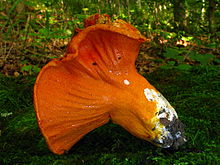
Typical mushrooms are the fruit bodies of members of the order
Within the main body of mushrooms, in the Agaricales, are common fungi like the common
, etc.An atypical mushroom is the

Other mushrooms are not gilled, so the term "mushroom" is loosely used, and giving a full account of their classifications is difficult. Some have pores underneath (and are usually called
Morphology
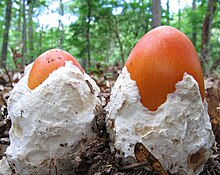

A mushroom develops from a nodule, or pinhead, less than two millimeters in diameter, called a primordium, which is typically found on or near the surface of the substrate. It is formed within the mycelium, the mass of threadlike hyphae that make up the fungus. The primordium enlarges into a roundish structure of interwoven hyphae roughly resembling an egg, called a "button". The button has a cottony roll of mycelium, the universal veil, that surrounds the developing fruit body. As the egg expands, the universal veil ruptures and may remain as a cup, or volva, at the base of the stalk, or as warts or volval patches on the cap. Many mushrooms lack a universal veil, therefore they do not have either a volva or volval patches. Often, a second layer of tissue, the partial veil, covers the bladelike gills that bear spores. As the cap expands the veil breaks, and remnants of the partial veil may remain as a ring, or annulus, around the middle of the stalk or as fragments hanging from the margin of the cap. The ring may be skirt-like as in some species of Amanita, collar-like as in many species of Lepiota, or merely the faint remnants of a cortina (a partial veil composed of filaments resembling a spiderweb), which is typical of the genus Cortinarius. Mushrooms lacking partial veils do not form an annulus.[11]
The stalk (also called the stipe, or stem) may be central and support the cap in the middle, or it may be off-center or lateral, as in species of usually do not have stalks, and a specialized mycological vocabulary exists to describe their parts.
The way the gills attach to the top of the stalk is an important feature of mushroom morphology. Mushrooms in the genera Agaricus, Amanita, Lepiota and Pluteus, among others, have free gills that do not extend to the top of the stalk. Others have decurrent gills that extend down the stalk, as in the genera Omphalotus and Pleurotus. There are a great number of variations between the extremes of free and decurrent, collectively called attached gills. Finer distinctions are often made to distinguish the types of attached gills: adnate gills, which adjoin squarely to the stalk; notched gills, which are notched where they join the top of the stalk; adnexed gills, which curve upward to meet the stalk, and so on. These distinctions between attached gills are sometimes difficult to interpret, since gill attachment may change as the mushroom matures, or with different environmental conditions.[12]
Microscopic features
A
In the basidiomycetes, usually four spores develop on the tips of thin projections called
The most important microscopic feature for identification of mushrooms is the spores. Their color, shape, size, attachment, ornamentation, and reaction to chemical tests often can be the crux of an identification. A spore often has a protrusion at one end, called an apiculus, which is the point of attachment to the basidium, termed the apical germ pore, from which the hypha emerges when the spore germinates.[13]
Growth
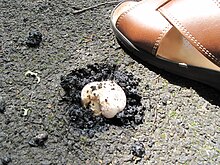
Many species of mushrooms seemingly appear overnight, growing or expanding rapidly. This phenomenon is the source of several common expressions in the English language including "to mushroom" or "mushrooming" (expanding rapidly in size or scope) and "to pop up like a mushroom" (to appear unexpectedly and quickly). In reality, all species of mushrooms take several days to form primordial mushroom fruit bodies, though they do expand rapidly by the absorption of fluids.[14][15][16][17]
The
Similarly, there are other mushrooms, like Parasola plicatilis (formerly Coprinus plicatlis), that grow rapidly overnight and may disappear by late afternoon on a hot day after rainfall.[18] The primordia form at ground level in lawns in humid spaces under the thatch and after heavy rainfall or in dewy conditions balloon to full size in a few hours, release spores, and then collapse. They "mushroom" to full size.[citation needed]
Not all mushrooms expand overnight; some grow very slowly and add tissue to their fruiting bodies by growing from the edges of the colony or by inserting
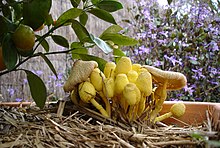
Though mushroom fruiting bodies are short-lived, the underlying
Nutrition
| Nutritional value per 100 g (3.5 oz) | |
|---|---|
| Energy | 94 kJ (22 kcal) |
4.3 g | |
| Dietary fiber | 0.6 g |
0.1 g | |
2.5 g | |
Niacin (B3) | 24% 3.8 mg |
| Pantothenic acid (B5) | 30% 1.5 mg |
| Vitamin B6 | 6% 0.11 mg |
| Folate (B9) | 6% 25 μg |
| Vitamin C | 0% 0 mg |
| Vitamin D | 0% 3 IU |
| Minerals | Quantity %DV† |
| Calcium | 1% 18 mg |
| Iron | 2% 0.4 mg |
| Magnesium | 2% 9 mg |
| Manganese | 6% 0.142 mg |
| Phosphorus | 10% 120 mg |
| Potassium | 15% 448 mg |
| Sodium | 0% 6 mg |
| Zinc | 10% 1.1 mg |
| Other constituents | Quantity |
| Water | 92.1 g |
| Selenium | 26 ug |
| Copper | 0.5 mg |
| Vitamin D (UV exposed) | 1276 IU |
| †Percentages estimated using US recommendations for adults,[22] except for potassium, which is estimated based on expert recommendation from the National Academies.[23] | |
Raw
Vitamin D
The
Human use
Edible mushrooms


Mushrooms are used extensively in
Most mushrooms sold in
China is a major edible mushroom producer.[31] The country produces about half of all cultivated mushrooms, and around 2.7 kilograms (6.0 lb) of mushrooms are consumed per person per year by 1.4 billion people.[32] In 2014, Poland was the world's largest mushroom exporter, reporting an estimated 194,000 tonnes (191,000 long tons; 214,000 short tons) annually.[33]

Separating edible from poisonous species requires meticulous attention to detail; there is no single trait by which all toxic mushrooms can be identified, nor one by which all edible mushrooms can be identified. People who collect mushrooms for consumption are known as mycophagists,[34] and the act of collecting them for such is known as mushroom hunting, or simply "mushrooming". Even edible mushrooms may produce allergic reactions in susceptible individuals, from a mild asthmatic response to severe anaphylactic shock.[35][36] Even the cultivated A. bisporus contains small amounts of hydrazines, the most abundant of which is agaritine (a mycotoxin and carcinogen).[37] However, the hydrazines are destroyed by moderate heat when cooking.[38]
A number of species of mushrooms are
Toxic mushrooms

Many mushroom species produce
Psychoactive mushrooms
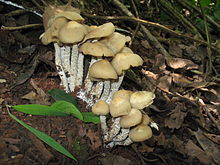
Mushrooms with psychoactive properties have long played a role in various native medicine traditions in cultures all around the world. They have been used as sacrament in rituals aimed at mental and physical healing, and to facilitate visionary states. One such ritual is the

A few species in the genus
Folk medicine
Some mushrooms are used in
Other uses

Mushrooms can be used for
Some fungi, types of
Mushrooms and other fungi play a role in the development of new biological remediation techniques (e.g., using mycorrhizae to spur plant growth) and filtration technologies (e.g. using fungi to lower bacterial levels in contaminated water).[53]
There is an ongoing research in the field of genetic engineering aimed towards creation of the enhanced qualities of mushrooms for such domains as nutritional value enhancement, as well as medical use.[54]
Gallery
-
Psychotropic mushroom Amanita muscaria, commonly known as "fly agaric"
-
Agaricus bisporus mushroom is a cultivated edible mushroom for foods and has many names such as "champignon", " button mushroom", "white mushroom", and " portobello"
-
Boletus edulis, also known as "cep", is an edible wild bolete found in Europe
-
Common puffball (Lycoperdon perlatum) has a glebal hymenium; the interior is white when it is young, but as it matures, the interior becomes brown containing spores
See also
- Fungiculture
- List of psilocybin mushroom species
- Largest fungal fruit bodies
- Lists of fungal species
- Mushroom poisoning
- Mushrooms in art
References
- ^ "Definition of TOADSTOOL". Archived from the original on 27 June 2022. Retrieved 26 June 2022.
- ISBN 978-0-00-728464-1.
- ^ Ramsbottom J. (1954). Mushrooms & Toadstools: a study of the activities of fungi. London: Collins.
- ^ Hay, William Deslisle (1887). An Elementary Text-Book of British Fungi. London, S. Sonnenschein, Lowrey. pp. 6–7.
- ISBN 978-0-89815-169-5.
- ^ "Toadstool". Online Etymology Dictionary, Douglas Harper, Inc. 2021. Archived from the original on 2 June 2021. Retrieved 30 May 2021.
- ISBN 978-0-442-21998-7.
- ^ Ammirati et al., pp. 40–41.
- ^ Volk T. (2001). "Hypomyces lactifluorum, the lobster mushroom". Fungus of the Month. University of Wisconsin-La Crosse, Department of Biology. Archived from the original on 2012-04-14. Retrieved 2008-10-13.
- ISBN 978-0-8493-1043-0.
- ^ Stuntz et al., pp. 12–13.
- ^ Stuntz et al., pp. 28–29.
- ^ a b c Ammirati et al., pp. 25–34.
- ISBN 9781444678925.
- ^ DLong (2019-08-29). "How Mushrooms are Grown". Canadian Food Focus. Retrieved 2023-06-19.
- ^ Sayner, Adam (2022-02-23). "How Long Does It Take To Grow Mushrooms? All Questions Answered". GroCycle. Retrieved 2023-06-19.
- ISBN 9798702942391.
- ^ Nelson N. (2006-08-13). "Parasola plicatilis". Archived from the original on 2013-01-02. Retrieved 2008-10-13.
- . Retrieved 18 November 2021.
- ISBN 978-0-674-06342-6
- ^ Dodge, S.R. "And the Humongous Fungus Race Continues". US Forest Service: Pacific Northwest Research Station. Archived from the original on 2011-04-07. Retrieved 2011-02-28.
- ^ United States Food and Drug Administration (2024). "Daily Value on the Nutrition and Supplement Facts Labels". Retrieved 2024-03-28.
- )
- ^ Haytowitz DB (2009). "Vitamin D in mushrooms" (PDF). Nutrient Data Laboratory, US Department of Agriculture. Archived (PDF) from the original on 1 February 2021. Retrieved 16 April 2018.
- PMID 22132934.
- PMID 19281276. Archived from the original(PDF) on 2011-07-22.
- ^ PMID 23485617.
- PMID 30322118.
- PMID 25685150.
- ^ Marshall, Elaine and Nair, N. G. (2009) Making Money by growing Mushrooms Archived 2022-11-28 at the Wayback Machine. Food and Agriculture Organization of the United Nations
- ^ "Production of Cultivated Edible Mushroom in China With Emphasis on Lentinula edodes - isms.biz". isms.biz. Archived from the original on 2017-02-02. Retrieved 2017-01-25.
- ^ Hall et al., p. 25.
- ^ "Poland: The world's largest mushroom exporter". Fresh Plaza. 8 April 2015. Archived from the original on 24 September 2016. Retrieved 23 September 2016.
- ISBN 978-0-292-75125-5.
- ^ Hall et al., pp. 22–24.
- ^ Ammirati et al., pp. 81–83.
- (PDF) from the original on 2021-04-27. Retrieved 2019-06-29.
- ^ Siegered, AA, ed. (January 1998). "Spore Prints #338". Bulletin of the Puget Sound Mycological Society. Archived from the original on 2010-07-17. Retrieved 2010-07-04.
- ^ "Preventing Poisonings - Bay Area Mycological Society". www.bayareamushrooms.org. Archived from the original on 2021-05-11. Retrieved 2021-05-11.
- ^ "Belarus exports radioactive mushrooms, April 2008". Freshplaza.com. Archived from the original on 2013-05-10. Retrieved 2014-01-24.
- S2CID 22133708.
- ISBN 978-0-691-07016-2.
- PMID 18593735.
- ^ Guzmán G, Allen JW, Gartz J (1998). "A worldwide geographical distribution of the neurotropic fungi, an analysis and discussion" (PDF). Annali del Museo Civico di Rovereto. 14: 207. Archived from the original (PDF) on 2010-06-26. Retrieved 2017-09-17.
- S2CID 31220680.
- S2CID 7845214.
- ^ "Clinical Sunday". maps.org. Archived from the original on 2014-04-05. Retrieved 2014-03-20.
- ^ from the original on 26 February 2022. Retrieved 2 July 2021.
- ^ "Coriolus Versicolor". American Cancer Society. 1 November 2008. Archived from the original on 25 June 2010. Retrieved 2011-03-01.
- S2CID 5643894.
- ^ "Mushrooms in cancer treatment". Cancer Research UK. 30 January 2015. Archived from the original on 15 November 2017. Retrieved 15 November 2017.
- ISBN 978-0-470-74496-3
- PMID 24949264.
- S2CID 4447141.
Literature cited
- Ammirati JF, Traquair JA, Horgen PA (1985). Poisonous Mushrooms of Canada: Including other Inedible Fungi. Markham, Ontario: Fitzhenry & Whiteside in cooperation with Agriculture Canada and the Canadian Government Publishing Centre, Supply and Services Canada. ISBN 978-0-88902-977-4.
- Hall IR, Stephenson SL, Buchanan PK, Yun W, Cole AL (2003). Edible and Poisonous Mushrooms of the World. Portland, Oregon: Timber Press. ISBN 978-0-88192-586-9.
- Stuntz DE, Largent DL, Thiers HD, Johnson DJ, Watling R (1978). How to Identify Mushrooms to Genus I. Eureka, California: Mad River Press. ISBN 978-0-916422-00-4.
External links
- . Encyclopædia Britannica. Vol. 19 (11th ed.). 1911. pp. 70–72.
- . Encyclopædia Britannica. Vol. 26 (11th ed.). 1911. p. 1035.
Identification
- Mushroom Observer, a collaborative mushroom recording and identification project
- An Aid to Mushroom Identification, Simon's Rock College
- Online Edible Wild Mushroom Field Guide




